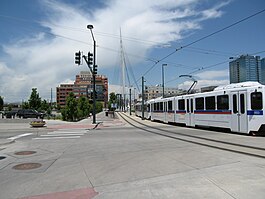C Line (RTD)
This article needs additional citations for verification. (December 2009) |
| C Line | |||
|---|---|---|---|
| C | |||
 Old alignment near Union Station | |||
| Overview | |||
| Status | Discontinued | ||
| Owner | Regional Transportation District | ||
| Locale | Denver metropolitan area | ||
| Termini | |||
| Stations | 12 | ||
| Service | |||
| Type | Light Rail | ||
| System | RTD Rail | ||
| Operator(s) | Regional Transportation District | ||
| History | |||
| Opened | April 5, 2002 | ||
| Closed | January 10, 2021 | ||
| Technical | |||
| Track gauge | 4 ft 8+1⁄2 in (1,435 mm) standard gauge | ||
| Electrification | Overhead line, 750 V DC | ||
| |||
The C Line was a light rail line, part of the rail system operated by the Regional Transportation District in the Denver-Aurora Metropolitan Area in Colorado.
History
[edit]The line was added to the system on April 5, 2002, to coincide with the opening of the Central Platte Valley Spur. Initially, C trains operated seven days a week, but ran to Littleton–Mineral station only during peak hours and sporting events. At all other times, C service operated to I-25/Broadway.
On May 3, 2003, C trains began operating to Littleton–Mineral station at all times.
With the opening of the Southeast Corridor on November 17, 2006, weekend C service was discontinued except for certain sporting events, with the new E line operating seven days per week.
On January 11, 2009, the midday service pattern between Union Station and I-25/Broadway was resumed and evening service discontinued.
Midday weekday service was discontinued on January 19, 2012 and was reinstated on August 17, 2014 over the entire route.
The C Line was suspended on January 10, 2021 as part of broader service cuts in response to ridership decreases related to the COVID-19 pandemic.[1] The line never returned to service and was officially eliminated ahead of the January 2023 service change.[2]
Stations
[edit]The C Line's northern terminus was at Union Station in Denver, ran on a railroad right-of-way south to its junction with the D Line at 10th & Osage Station, and shared track with the D Line until both lines reach their southern terminus at Mineral Avenue in Littleton.[3]
In addition, the C Line provided access to the sports venues of Denver – Coors Field, Pepsi Center, and Broncos Stadium at Mile High – Six Flags Elitch Gardens, and LoDo, as well as access to the western portion of the Auraria Campus.
| Station | Municipality | Opening date |
Interchange |
|---|---|---|---|
| Union Station | Denver | April 5, 2002 | |
| Ball Arena–Elitch Gardens | |||
| Empower Field at Mile High | |||
| Auraria West | |||
| 10th & Osage | October 8, 1994 | ||
| Alameda | Park and ride: 240 spaces | ||
| I-25 & Broadway | Park and ride: 1,248 spaces | ||
| Evans | July 14, 2000 | Park and ride: 99 spaces | |
| Englewood | Englewood | Park and ride: 910 spaces | |
| Oxford–City of Sheridan | Sheridan | ||
| Littleton–Downtown | Littleton | Park and ride: 361 spaces | |
| Littleton–Mineral | Park and ride: 1,227 spaces |
FasTracks
[edit]The 2004 voter approved FasTracks plan will add 2.5 mi (4.02 km) to the Southwest Corridor (C Line and D Line). It will also add a station with 1,000 parking spots at C-470 and Lucent Boulevard in Highlands Ranch. There may also be a station at C-470 and Santa Fe Boulevard.[4]
References
[edit]- ^ Richards, Makayla (10 January 2021). "RTD service changes take effect Sunday". 9News. 10 January 2021. Retrieved 6 June 2021.
- ^ Murray, Jon (2022-12-14). "RTD is officially killing its C and F lines after suspending them during the pandemic". The Denver Post. Retrieved 2022-12-16.
- ^ "RTD – Light Rail System Map". Regional Transportation District. Retrieved June 2, 2014.
- ^ "Fastracks – Southwest Corridor". Regional Transportation District. Retrieved April 11, 2010.


